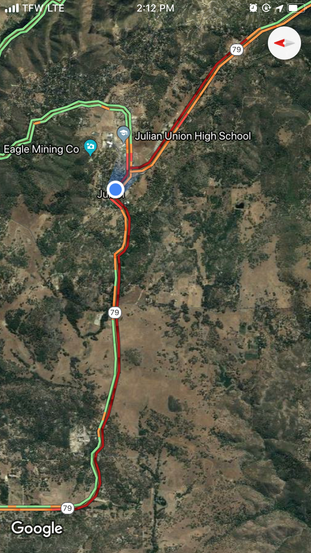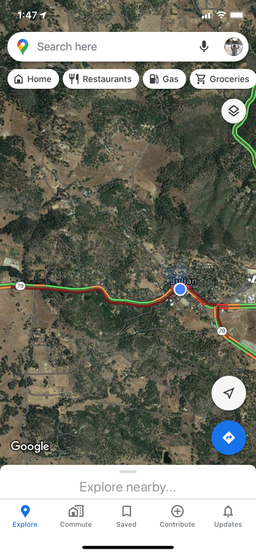Guide to Experiencing Snow in the San Diego Mountains
- Eva Hatch
- Jan 7, 2018
- 10 min read
Updated: Mar 10, 2022

Does it snow in San Diego? Yes, it snows in San Diego – the mountains in San Diego County do get snow a couple of times a year! In about a two hours drive, you can go from surfing to snowball fights to the hot desert sun. It's really one of my favorite aspects of San Diego.
The nearest snow to San Diego can be found about an hours drive east outside the city in the communities of Julian (elevation 4,226′), Lake Cuyamaca (elevation 4,613′ to 6,515'), Palomar Mountain (elevation 6,142′), Mount Laguna (elevation 6,378′), Pine Valley (elevation 3,737'), Hot Springs Mountian (elevation 6,526′), and the surrounding high elevation areas.
For those coming to play in the snow, here's some local advice for experiencing snow in San Diego.
How do you know if there's snow in the SoCal mountains?
There are a few ways to tell if the higher elevations in San Diego have snow:
Check the local web cameras:
From just about anywhere in San Diego City, looking east you can see the local mountains. Is there snow on them?
Turn on a local news station. Snow in San Diego is a big news story. If there's snow, the news will be covering it.
Call the Julian Chamber of Commerce, (760) 765-1857
Please refrain from directly contacting local businesses or residents about snow levels. Companies receive thousands of inquires about snow and responding to such prevents them from serving their customers efficiently. Snow days bring large crowds and informational inquires slow down service.
Snow Levels
The San Diego mountains get anywhere from a dusting to a few feet on a rare occasion at one time.
Unlike Big Bear or Mammoth, snow in the San Diego mountains doesn't last long. Typically, the snow may even start melting the same day. How long the snow lasts depends on the snow level and the length of the cold spell. Most of the time the snow melts within a day or two. So, if you want to come up for the snow don't dilly dally!
The San Diego region has been known to get snowfall as early as November and as late as Mother's day in May. Julian gets most of our snow from January to March.
The local mountains range in altitudes from 2,000' to Hot Springs Mountian towering over America's finest city at an elevation of 6,526′. This causes some areas to have snow while others will have none. Snow lasts longer in high elevations areas like Palmar Mountain, Mount Laguna, and Lake Cuyamaca compared to lower elevations like Julian and Pine Valley.
Julian (elevation 4,226′) averages precipitation 56 days a year and 24.0 in. snowfall calculation.
Lake Cuyamaca (elevation 4,613′ to 6,515') 31.5 snowfall calculation
Palomar Mountain (elevation 6,142′) averages an annual snowfall of 6.8in.
Mount Laguna (elevation 6,378′) averages an annual snowfall of 13.4 in.
Pine Valley (elevation 3,737') averages an annual snowfall of 13.1 in.
Hot Springs Mountian (elevation 6,526′)
Plan in Advance
Snowstorms in SoCal can be a bit tricky to predict with accuracy until the storm arrives.
Check the weather forecast here. This does not stop the masses from venturing out in hopes of finding snow. Do all your necessary preparations while the storm is developing so that you can get the most out of a snow day.
To have the best possible San Diego snow day experience, I recommend booking a vacation rental. This allows you to arrive before the storm hits, you have a yard to play in the snow, and as long as you stay put you don't have to drive in dangerous road conditions.
Those doing a snow day trip to Julian, Palomar, or Mount Laguna arrive early in the day. The region is crowded by noon.
Road Conditions and Snow Chains

Be sure to check the road conditions before you head up the backcountry roads to play in the snow.
DRIVING IN THE SNOW IS AN ACQUIRED SKILL.
It's strongly recommended that a driver with experience driving in snow, is the one that drives. It's not easy to drive with snow and ice on the windy roads.
Always make sure you have the proper size chains for your vehicle and know how to put them on before you head up the hill.
Stopping in the middle of the road to put them on is not safe.
Car accidents increase dramatically when there's snow. We have a very limited amount of emergency resources in the mountains. Resources are limited and stretched to the max with a sudden, dramatic increase of visitors. Lastly, it's strongly advised to fill up on gas before you head up the 78 or 79. We only have one gas station in town.
Public roads in the unincorporated communities are maintained by CalTrans and San Diego County. These agencies do plow public roads after snow accumulates. During and following snowstorms, all vehicles are REQUIRED to have snow chains to pass through checkpoints along Highway 78, Highway 79, Freeway 8, and Sunrise Highway. All-wheel-drive or 4x4, and snow tires may also be required. We often have lots of black ice and causing many cars stranded, damaged, and towed.
For current road restrictions, chain requirements, and conditions, you will need to check with Caltrans or CHP (select the Border section) sites at your time of travel.
Where can you sled, and play in the snow?
Julian, Lake Cuyamaca, Mount Laguna, and Palomar Mountain are the best places to see snow in San Diego.
The area surrounding Julian has numerous hills, but not all of them are open for sledding. These mountain communities do not have designated places for the public to play in the snow, like ski resorts.
Please be mindful of where you stop to play. Most of the region is privately owned. We ask that you take a little extra time in making sure you're on public lands and not private property.
Even if you are on public land, we ask that you stay respectful of the land, wildlife, and natural resources as you play.
Here's a list of public spots you can play in the snow at:
Julian:
SoCal locals and visitors flock to the townsite of Julian at the first mention of snow. The area is mainly residential. The public can play in the snow at William Heise County Park, Jess Martin County Park, Julian Museum & Pioneer County Park, Cuyamaca Rancho State Park, Lake Cuyamaca Recreation & Park, and Whispering Winds Catholic Camp & Conference Center (Reservations Required). These recreation areas have a day-use fee.
Snow play is not allowed on private property, in the street, at Frank Lane Park Memorial, on the hill adjacent to Jess Martin Park, and in the Pioneer Cemetary.
Lake Cuyamaca:
Down the road from Julian proper in the Cuyamaca area, snow visitors can play at designated day-use areas within the Cuyamaca Rancho State Park and at the Lake Cuyamaca Recreation Area & Park. Both of these recreation areas have a day-use fee. Please note that parking is not allowed along Highway 79.
Mount Laguna:
When Sunrise highway is open, snow recreation is allowed at designated day-use areas within Cleveland National Park and the Mount Laguna Recreation area. These recreation areas have a day-use fee.
Palomar Mountain:
On Palmar Mountain Palomar, one can experience snow at designated day-use areas within the Palomar Mountain State Park. This recreation area has a day-use fee.
Hot Springs Mountian:
The Los Coyotes Band of Cahuilla and Cupeno Indians do allow non-tribal members on the reservation for day-use hiking and camping. This recreation area has a day-use fee.
*Recreation areas may have day-use fees. These fees help pay for maintenance and services.*
When dirt and ground covering can be seen through the snow, it is time to find a new place to play in the snow. Over sledding cuts ruts into the ground that destroy the natural ground cover.
It is vital that you leave no trace when you visit the local mountains.
The snow oftentimes covers signs and fences. You can be convicted of a misdemeanor for trespassing and subject to fines.
Do NOT play on private property, on the highway, in the Julian Pioneer Cemetary (see video above), in Frank Lane Memorial Park in neighborhoods, and in unsafe areas.
Lastly, on just about all major roads partially the highways, there is no parking allowed along the road. No parking means NO PARKING. Illegal parking adds to traffic congestion. Local law enforcement does patrol the area. Cars parked in no parking areas will be ticked and the vehicle may be towed.
When To Come
Weekdays are the best time to come all year long especially when there's snow.
During a holiday snowfall, we get thousands of visitors per day trying to play in the snow. In 2015, one local estimated over 30,000 visitors trying to come to Julian in a single day. Only about 4,000 people live here. Arrive early in the day. The mornings are icy but everywhere will be packed by noon.
Expect Crowds
This is your fair warning, snow days bring LARGE amounts of visitors to the mountains. See photos above.
The San Diego backcountry infrastructure was not designed to accommodate for such spontaneous large amounts of tourism therefore there is lots of congestion on high tourism days. Our local emergency agencies (fire department, towing, etc) are staffed to accommodate the local population, and staffing is not increased on busy tourism days.
It is critical that you clean up after yourself. There is no local government entity to clean up after the visitors. Additionally, we have no way to dispose of the trash left behind. The region also has a major bathroom shortage.
What To Bring
Bring all your waterproof snow gear with you (snow gloves, pants, jacket, and boots). Few stores carry a very limited variety and supply of snow gear/winter clothing.
Expect it to be colder than you imagine. Sorry ladies but high heels are not a good choice when there's snow/ice on the ground.
Bring a change of clothes for everyone. Even with waterproof clothes, you're probably going to be dripping wet and cold after playing in the snow.
Be prepared with water and food for your group.
Playing in and eating snow dehydrates you so bring lots of water. After a long drive and playing, you're sure to get hungry.
On snow days local restaurants have extended times. You may have to wait two-plus hours to eat at a local restaurant. That's not an exaggeration, so come prepared! If you do decide to wait it out, please be patient with the staff. They are doing their best to serve everyone in a timely manner.
Snowday Packing Check List
4WD/AWD vehicle with snow tires, working headlights, working windshield wipers, and the proper size chains for your tires
Snow gloves
Snow pants
Snow jacket
Snow boots
Extra snow gear
Snow toys
Change of clothes
Food and water
Cash
Your AAA card
Trash bags for the trash you create and wet clothes
Snow shovel, for if you get stuck.
Where can you buy a sled in Julian? Julian Market and Deli, Jack's Grocery & Deli, the tackle shop at Lake Cuyamaca, and the Mount Laguna Store. Supplies are limited and demand is high.
A limited selection of snow gear (hats, scarfs, gloves, socks) can be found at Julian Market and Deli, Julian Mercantile, and the Mount Laguna Store. Supplies are limited and demand is high.
Pets
For the health and safety of your pets, it is strongly advised against bringing your dogs with you to experience the snow.
Most dogs aren't used to windy roads and long car drives. During snowstorms, the San Diego mountain regions experience LARGE amounts of traffic which means that you and your pet will be cooped in the car for an extended period of time. San Diego dogs aren't acclimated to the cold weather and walking on snow/ice. If you are cold, so are your pets. The snow, ice, and wet pavement are extremely cold for dogs to walk on.
When there's snow, outdoor dining is limited or closed. This means you will need to leave your pet in the car for extended periods of time.
In December of 2020, I witnessed a nasty dog fight in the Julian Historical District. I have also witnessed many close calls. We only have one animal hospital with very limited hours in Julian.
Jess Martin Park is the only place dogs are allowed to run off their lease in the designated no-leash area from August 1st to January 1st. The Cuyamaca Rancho State Park and Palomar State Park only allow leashed dogs on select paved areas. This means the dogs are not allowed throughout most of the park, including where visitors play in the snow. Dogs are permitted in the National Forest Wilderness. Once you enter the Cleveland National Park, dogs are not permitted. Pets are only allowed in certain areas for your animals' safety, public safety, to preserve the natural habitat, and due to wildlife.
Law enforcement is very present on snow days and will enforce the rules.
Please be considerate of your pet before you bring them into this environment.
If you bring your pets with you they need to be comfortable around large crowds, strange dogs, and being left in the car. You need to bring pet food, water/bowl, collar/leash, poop bags, a warm dog coat, and paw bodies. These items are not sold in any local retailers.
Pick up after your pets.
Heading Home
Snow accumulation plays a vital role in the local water supply. It is important to leave the snow for others to enjoy and for the local watershed. Do not block your windshield with snow. Driving with a blocked windshield is not safe and puts others in harm's way.
We are very grateful for everyone who finically supports our community through purchases made at the local businesses. Without tourism, our local economy would greatly suffer. Every dollar spent is multiplied throughout our community. From creating jobs for locals to funding the nonprofits that support the community's needs. Tourism financially supports the mountain community.
That being said the revenue it brings in isn’t enough to keep up with the infrastructure demand needed to support tourism on the scale we receive. It’s a “they come and we try to build it” situation. That is why we need visitors to help maintain the region by leaving no trace when they visit.
Please please take everything you bring with you back home. Our mountains are beautiful and home to lots of wildlife. It's always a very sad sight to see when they are covered in trash. There is no local government entity to clean up after the visitors. Additionally, we have no way to dispose of the trash left behind.
We ask that you please help us maintain a clean environment for the animals and the generations to come. Do not leave trash of any kind including, but not limited to sleds, dirty diapers, snow gear, and more. Anyone who litters can be fined up to $1,000 and community service (see the law here).
As always, thank you for supporting our community.
Have a safe trip!
All photos and content is copyright of Eva Hatch and use without permission is prohibited.
© 2017 - 2022 by Eva Hatch.


















